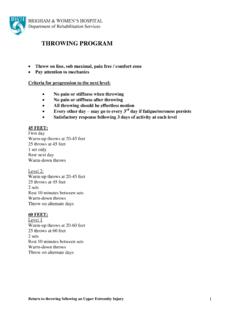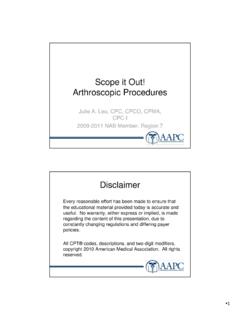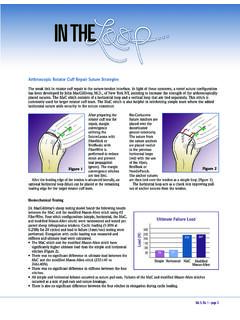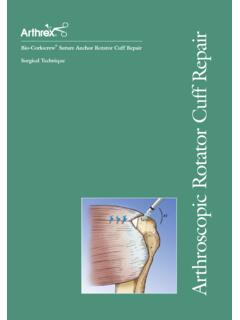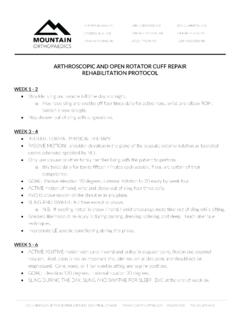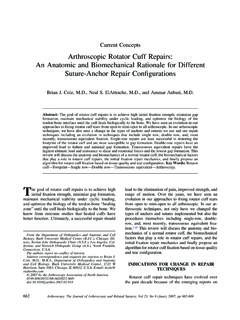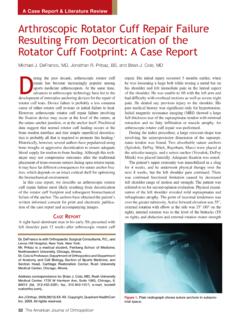Transcription of Rotator Cuff Repair Protocol - Boston Shoulder Institute
1 Department of Rehabilitation Services Physical Therapy arthroscopic Rotator cuff Repair Protocol : The intent of this Protocol is to provide the clinician with a guideline of the post-operative rehabilitation course of a patient that has undergone an arthroscopic assisted/mini-open Rotator cuff Repair . It is no means intended to be a substitute for one s clinical decision making regarding the progression of a patient s post-operative course based on their physical exam/findings, individual progress, and/or the presence of post-operative complications. If a clinician requires assistance in the progression of a post-operative patient they should consult with the referring Surgeon. Progression to the next phase based on Clinical Criteria and/or Time Frames as Appropriate.
2 Phase I Immediate Post Surgical Phase (Weeks 1-4): Goals: Maintain integrity of Repair Diminish pain and inflammation Prevent muscular inhibition Independent with ADL s with modifications while maintaining the integrity of the Repair . Precautions: No active range of motion (AROM) of Shoulder Maintain arm in sling, remove only for exercise No lifting of objects No Shoulder motion behind back No excessive stretching or sudden movements No supporting of body weight by hands Keep incision clean and dry Criteria for progression to the next phase (II): Passive range of motion (PROM) Flexion to at least 100 degrees PROM ER in scapular plane to at least 45 degrees PROM IR in scapular plane to at least 45 degrees arthroscopic Rotator cuff Repair Protocol : Copyright 2007 The Brigham and Women's Hospital, Inc.
3 Department of Rehabilitation Services. All rights reserved. 1 PROM Abduction to at least 90 degrees in the scapular plane arthroscopic Rotator cuff Repair Protocol : Copyright 2007 The Brigham and Women's Hospital, Inc. Department of Rehabilitation Services. All rights reserved. 2 DAY 1 TO 6: Abduction brace / sling Sleep in brace / sling Begin scapula musculature isometrics / sets; cervical ROM Patient education: posture, joint protection, positioning, hygiene, etc. Cryotherapy for pain and inflammation -Day 1-2: as much as possible -Day 3-6: post activity, or for pain DAY 7 TO 28: Continue use of brace / sling Pendulum Exercises (to begin 21 days after surgery, no pendulums before this time) Start passive ROM to tolerance (at 21 days) -Flexion -Abduction in the scapular plane -ER in scapular plane -IR in scapular plane Continue Elbow, wrist, and finger AROM / resisted Cryotherapy as needed for pain control and inflammation Phase II Protection Phase (Week 4-10): Goals: Allow healing of soft tissue Do not overstress healing tissue Gradually restore full passive ROM (week 4-5) Decrease pain and inflammation Precautions.
4 No lifting No supporting of body weight by hands and arms No excessive behind the back movements No sudden jerking motions Criteria for progression to the next phase (III): Full AROM WEEK 5-6: Continue use of brace / sling full time until end of week 5 Between weeks 5 and 6 may use brace / sling for comfort only Discontinue brace / sling at end of week 6 arthroscopic Rotator cuff Repair Protocol : Copyright 2007 The Brigham and Women's Hospital, Inc. Department of Rehabilitation Services. All rights reserved. 3 Initiate active assisted range of motion (AAROM) flexion in supine position Progressive passive ROM until approximately Full ROM at Week 4-5. This ROM should be PAIN FREE Gentle Scapular/glenohumeral joint mobilization as indicated to regain full passive ROM Continue previous exercises in Phase I as needed Continue all precautions Initiate prone rowing to neutral arm position Continue cryotherapy as needed May use heat prior to ROM exercises May use pool (aquatherapy) for light ROM exercises Ice after exercise WEEK 6-8: Continue AAROM and stretching exercises Begin Rotator cuff isometrics Initiate active ROM exercises - Shoulder flexion scapular plane - Shoulder abduction Phase III Intermediate phase (week 10-14): Goals.
5 Full AROM (week 10-12) Maintain Full PROM Dynamic Shoulder Stability Gradual restoration of Shoulder strength, power, and endurance Optimize neuromuscular control Gradual return to functional activities Precautions: No heavy lifting of objects (no heavier than 5 lbs.) No sudden lifting or pushing activities No sudden jerking motions Criteria for progression to the next phase (IV): Able to tolerate the progression to low-level functional activities Demonstrates return of strength / dynamic Shoulder stability Re-establish dynamic Shoulder stability Demonstrates adequate strength and dynamic stability for progression to higher demanding work/sport specific activities. WEEK 10: arthroscopic Rotator cuff Repair Protocol : Copyright 2007 The Brigham and Women's Hospital, Inc.
6 Department of Rehabilitation Services. All rights reserved. 4 Continue stretching and passive ROM (as needed) Dynamic stabilization exercises Initiate strengthening program -External rotation (ER)/Internal rotation (IR) with therabands/sport cord/tubing -ER Sidelying -Lateral Raises* -Full Can in Scapular Plane* (avoid empty can abduction exercises at all times) -Prone Rowing -Prone Horizontal Abduction -Prone Extension -Elbow Flexion -Elbow Extension *Patient must be able to elevate arm without Shoulder or scapular hiking before initiating isotonics; if unable, continue glenohumeral joint exercises WEEK 12: Continue all exercise listed above Initiate light functional activities WEEK 14: Continue all exercise listed above Progress to fundamental Shoulder exercises Phase IV Advanced strengthening phase (week 16-22): Goals: Maintain full non-painful active ROM Advance conditioning exercises for Enhanced functional use of UE Improve muscular strength, power, and endurance Gradual return to full functional activities WEEK 16: Continue ROM and self-capsular stretching for ROM maintenance Continue progression of strengthening Advance proprioceptive, neuromuscular activities WEEK 20.
7 Continue all exercises listed above Continue to perform ROM stretching, if motion is not complete Phase V Return to activity phase (week 20-26): arthroscopic Rotator cuff Repair Protocol : Copyright 2007 The Brigham and Women's Hospital, Inc. Department of Rehabilitation Services. All rights reserved. 5 Goals: Gradual return to strenuous work activities Gradual return to recreational activities Gradual return to sport activities WEEK 23: Continue strengthening and stretching Continue stretching, if motion is tight WEEK 26: May initiate interval sport program ( golf, etc.), if appropriate Author: Reg B. Wilcox III Reviewd/Updated 11/06, 12/07





